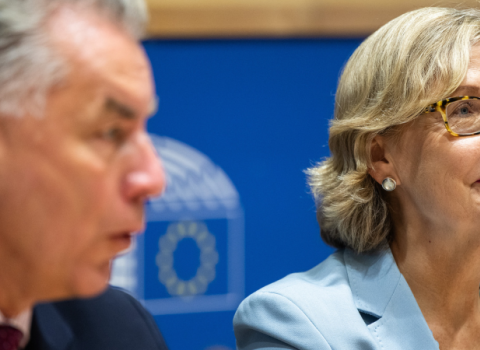Success rates are up, UK and Swiss participation down, and Widening countries edge up to the EU 27 average. And on the third anniversary of Brexit, the UK’s five top universities, usually among the biggest winners of EU R&D funding, are feeling the pinch

Horizon Europe is heading into its third year, and the latest statistics offer a glimpse of how the EU is spending its €95.5 billion research funding pot.
To date, the Commission has disbursed €11.83 billion, or around 12.4% of the budget, in the first two years of the seven-year programme.
What is most startling about the data, is the impact of Brexit and the country’s subsequent non-association, on the level of UK participation, and in particular on its five leading universities. Despite a national safety net that replicates EU funding, participation by UK companies, universities and individuals has fallen by half.
Oxford University, which won €523 million over the seven years of Horizon 2020, has been awarded €2 million in the first two years of Horizon Europe. Cambridge University, recipient of a total of €483 million from Horizon 2020, has not received any Horizon Europe funding to date.
While the total amount of Horizon Europe funding disbursed so far may seem low, it is typical for the greatest proportion of the money to be handed out in the last few years of EU research programmes. The last framework programme, Horizon 2020, had an overall budget of €77 billion of which €13.5 billion, or 17%, was spent in 2020, the last year of the programme.
On top of that, around 5% of the money committed to research in framework programmes does not make it to scientists each year, because the estimated project budgets end up not matching the EU’s actual contribution. Some of these so-called ‘decommitments’ are then returned to the €95.5 billion research budget. Since 2021, this ‘reconstituted’ money has come to €286 million.
On the bright side, with almost 5,000 grants signed, success rates are up. According to the latest (January) statistics, the number is just over 16%, up from 15.8% in July 2022. While many excellent proposals get turned away, the situation is better than Horizon 2020, where the success rate was 12%.
Here’s the breakdown of the rest of the biggest trends, with a note that the current numbers on the Horizon Dashboard include data on proposals and grants signed up until 5 December. The next update, which will include all 2022 data, is due mid-February.
Non-association hits UK participation hard
UK participation in Horizon Europe – that is the percentage of total participants the UK accounts for, not the absolute number - has fallen by half compared to Horizon 2020. Having been one of the top three countries by number of participating entities – be they individuals, universities or companies – the UK is now beaten by Belgium in the league table of Horizon Europe activity.
In one sense, this is hardly surprising. The UK is not associated to Horizon Europe, the result of a long-running saga of distrust and recrimination following Brexit that has meant the Commission is refusing to sign off on association, even though it was agreed in the UK exit treaty.
This means that UK-based researchers are not allowed to receive grants from the European Research Council, an area of the framework programme where they have traditionally excelled. They are still applying to the ERC and being successful – it’s just that while association isn’t agreed, UK winners are being funded by a replica scheme run by UK Research and Innovation (UKRI), not the ERC itself. This restriction accounts for some of the drop off in participation.
But it may not explain all of it. UK researchers and companies are still allowed to take part in pillar 2 projects, the consortia tackling industrial and global challenges that account for the bulk of Horizon’s budget. However, the UK has fallen behind in this part of Horizon too, dropping from 6.8% of participations to 5%, tumbling from fifth to eighth in the league table of engagement.
And notably, UK overall participation has fallen much more steeply than for Switzerland, which is also not associated to Horizon Europe because of the dispute about its wider relationship with the EU.
"The scale of the drop in the UK’s participation in Horizon Europe is deeply concerning, both for UK universities and for European science as a whole,” said Paul Boyle, vice chancellor of Swansea University, and a board member of Universities UK. “While the UKRI funding guarantee is helpful, researchers need and deserve more certainty about the long-term status of the UK in Horizon Europe.”
UK participation has been declining since 2016
UK engagement in EU research has been waning since 2016, when the country voted to leave the EU. Normally, each year of a framework programme sees more engagement than the last, as it cranks into gear. But the opposite trend was visible for the UK in Horizon 2020.
Widening countries match EU average success rate
It is approaching a decade since the Widening participation and spreading excellence programme was launched with the goal of closing the innovation gap between Europe’s top and low performers.
The extent to which Widening measures have worked is an open and ongoing debate, but the latest Horizon Europe figures do suggest a certain level of success in terms of the percentage of grant proposals from Widening countries that are accepted.
As the table above shows, the average success rate of Widening countries in obtaining funding through Horizon Europe is about equal to the EU 27 average, at just over 20%.
Slovakia and Latvia have so far had the highest proposal success rate under Horizon Europe of any EU member state, with the most successful non-Widening country, Belgium, having 23.65% of proposals accepted.
(The success rates for Widening countries and the EU27 average are higher than the 16%-plus figure given in the earlier table because that includes associated countries with lower success rates. For example, the success rate for Algeria is 8.3%).
Under Horizon 2020, the average success rate of Widening countries was 13.1%, compared to 13.9% for the EU 27 average.
The success rate under Horizon Europe has improved across the board, with various possible factors including increased funding, continuity from previous framework programmes, the non-participation of the UK and Switzerland, etc. You can read more about the reasons in our article here.
While this may seem positive for Widening countries, other metrics show just how far they have to go to close the innovation gap.
The table below shows the percentage of total net EU contributions that Widening countries have received under Horizon Europe. The top-performing country, Germany, has proportionally received more than all of the Widening countries put together.
Biggest winners of Horizon Europe
With the UK and Switzerland out of Horizon Europe, the money flows to Europe’s biggest research institutions are changing – drastically so, in the case of the UK’s top five universities.
Aside from UK and Swiss institutions, most of the top 20 biggest beneficiaries in Horizon 2020 keep their place in the leaders’ table. France’s National Centre for Scientific Research (CNRS) remains the biggest beneficiary of Horizon Europe, thus far having secured €198 million, repeating its Horizon 2020 success.
UK and Swiss exclusion has allowed some of the bigger European universities, such as Aarhus University and Ghent University, to climb into the top 20.
Who’s out? University College London, University of Oxford, EPFL, Imperial College London, University of Edinburgh, University of Cambridge and ETH Zürich.
Who’s in? Aarhus University, GEANT - the association of European National Research and Education Networks, Ghent University, University of Vienna, VTT Technical Research Centre of Finland, University of Oslo and France’s agricultural research institute INRAE.
Editor’s note: this article has been amended to correct Paul Boyle’s position.





 A unique international forum for public research organisations and companies to connect their external engagement with strategic interests around their R&D system.
A unique international forum for public research organisations and companies to connect their external engagement with strategic interests around their R&D system.